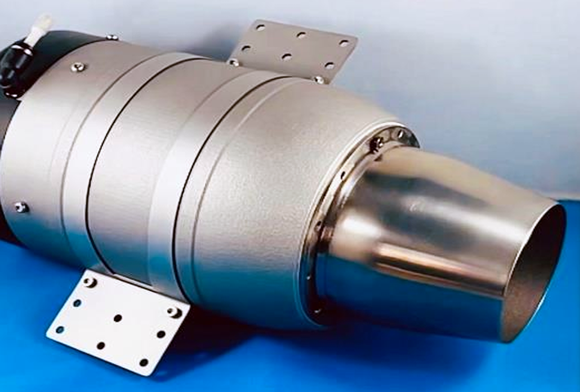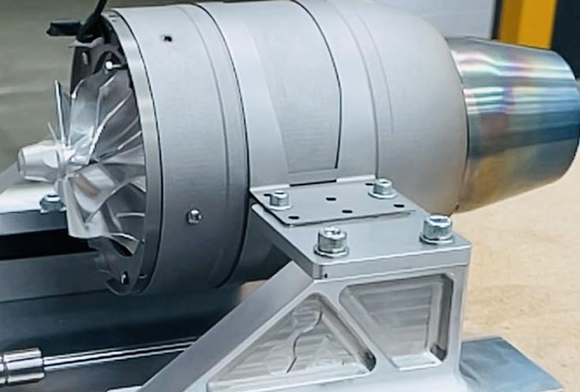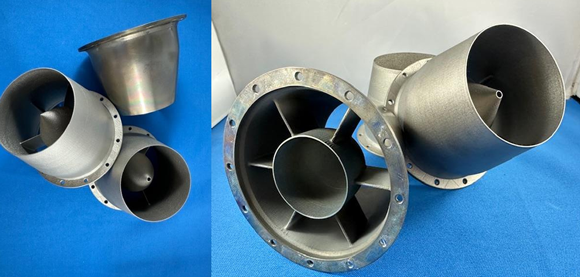Aurora Labs manufactures gas turbine engines with additively manufactured parts
April 9, 2024

Aurora Labs Limited (A3D), headquartered in Canning Vale, Australia, has announced the latest development of its 200N Class gas turbine. The new model, offering a lightweight propulsion system for use in a broad range of markets, will be available as early as next month. In parallel, the development of a 400N Class model is said to be progressing well.
A micro gas turbine is a combustion engine at the centre of a small propulsion system or power plant that can convert natural gas or other liquid fuels to mechanical energy for requirements in applications, including unmanned aerial vehicles or instant power generation.
“3D metal printing has worked to its strength in accelerating the product prototyping process of A3D’s sovereign turbine engine,” shared Rebekah Letheby, CEO. “The team has manufactured an advanced product in under four months. The turbine engine design and printing has successfully met benchmarks for laboratory prototype testing, which is at the cutting edge of high-energy 3D metal printing of components. Testing will now move to the field where the engine can be fitted to a remotely piloted airframe.”
“We have an excellent level of interest for A3D’s printed engines which also have application not only to unmanned aerial vehicles, but also instant power generation. It is our goal to have a cutting-edge piece of technology to sell to the sizeable defence and aerospace markets,” she continued.

Turbine development
In the development of the prototype turbine engine, A3D states it has met market-established benchmarks for its 200N Class turbine engine, including the required thrust, air intake efficiencies, engine weight and fuel consumption constraints. The company added that it has further scope for improvement through generative design changes, made possible with Additive Manufacturing.
The engine operates and compares in function and performance requirements to comparable engines built by traditional manufacturing methods. The advantage of the A3D engine is that it has fewer complex parts, resulting in a fast and reliable assembly process without compromising on performance. A3D reportedly has the Additive Manufacturing machines and experience to carry out production runs of the engine onshore in Australia.
The efficiency and weight of turbines are some of the key areas of A3D’s testing focus. These two items are linked in A3D’s turbine model by selecting individual parts which can be lightweighted through design, but also to select metal materials which ensure efficient material performance and allow for a reduction in overall mass. A lighter engine will benefit aircraft with improved fuel efficiency.
The design team is also focusing on ensuring that parts of the A3D turbine are amalgamated and manufactured as one assembly. While this is not currently possible for all parts, the reduction in the current number of parts has ensured that the time taken to assemble the engine is optimised, and the ease of assembly is also improved by using fewer parts. In one section of the engine, the company has managed to take eighteen parts and amalgamate that into just one additively manufactured part, all while realising a 20% weight reduction on traditional engines of the same class.

The metal materials selected for the additively manufactured parts show the required mechanical strength. Testing has shown that the manufactured interior components can perform with the required metallurgy withstanding the stress and high temperature that the metal material is subject to during the firing of the engine. The manufactured material is reportedly comparable to conventional metal materials which gives assurance to users that the end quality of the metal product is reliable and repeatable with the A3D manufacturing method.
Fuel type is also of consideration with the A3D turbine able to run on Jet-A1, kerosene and diesel fuels. This enables the end user the opportunity to use the turbine in many different environments, where specific fuel types may not be readily available.
Defence and aerospace industry engagement
A3D has actively demonstrated its current version of its additively manufactured gas turbine engine. Data from the current testing round will be supplied to several prospective customers who have requirements for gas turbine systems in various applications, including propulsion of unmanned aerial vehicles or instant power generation.
The supply of A3D’s engine — which is sovereign designed, manufactured and assembled — is of particular importance in supporting defence capabilities which are Australian-based and fits well with the pillars of the Australian Defence Review, 2023.
Additively manufactured metal parts and the use of Additive Manufacturing in the defence and aerospace industries will continue to be promoted to both large and small enterprises seeking innovative solutions provided by Additive Manufacturing, particularly with targeted geometries which excel in metal Additive Manufacturing. In parallel, the company continues to work towards delivery of the first AL250 machine.
Download Metal AM magazine

















